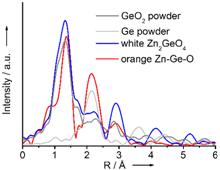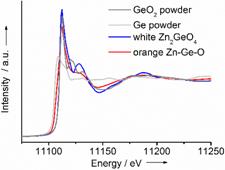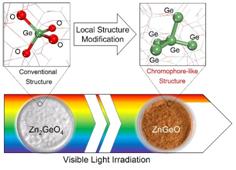| Orange Zinc Germanate with Metallic Ge-Ge Bonds as a Chromophore-Like Center for Visible-Light-Driven Water Splitting |
| From: PublishDate:2016-06-03 Hits: |
With decreasing dimension, materials exhibit properties which bulk materials do not have. These properties and their related phenomena have attracted more and more attention nowadays. From the 1960s, bismuth (Bi) has drawn great interest for its low carrier concentration, small effective carrier mass and large Fermi wavelength. With the given special properties of bulk Bi, one of the interesting and appealing problems is to manipulate its electronic structure in thin films to switch Bi from a semimetal to an insulator or semiconductor by the quantum size effect. Although there have been considerable efforts in electrical conductance and Hall transport as well as Angle Resolved Photoemission Spect The efficiency of solar-energy-conversion devices depends on the absorption region and intensity of the photon collectors. Organic chromophores, which have been widely stabilized on inorganic semiconductors for light trapping, are limited by the interface between the chromophore and semiconductor. A team from East China University of Science and Technology has developed a novel orange zinc germinate (Zn-Ge-O) with a chromophore-like structure, by which the absorption region can be dramatically expanded. Their research has been published on Angewandet Chemie International Edition on August 20th 2015. The team synthesized orange zinc germinate with visible-light response, gained the structural information, and tested the photocatalytic activity under visible irradiation. Structural characterizations revealed that the orange zinc germinate is amorphous, and the range of absorption wavelength had been expanded to 700 nm. The bonding structure in orange zinc germinate had changed compared to crystallized Zn2GeO4. Under visible light, the orange zinc germinate exhibited excellent activity of photocatalytic water splitting.
The structural information of orange zinc germanate obtained by 1W1B-XAFS Station of Beijing Synchrotron Radiation Facility (BSRF). There were metallic Ge-Ge bonds inside the Zn-Ge-O. The length of Ge-Ge bond and coordination number of Ge-O and Ge-Ge could be achieved by systematic fitting. The reviewer spoke highly of this work: “The development of orange zinc germanate and applying it in direct water splitting are novel. The authors indicated that the Ge-Ge metallic bonds function as chromophore and generate the carriers to drive the photochemical processes. The communication represents a unique contribution to the recent publications in developing new catalysts for solar-driven water splitting.” The research exhibits new sight into the role of bonding structure in narrowing semiconductors’ bandgap, and provides scientific clues for developing new inorganic semiconductor with visible light response. In this work, BSRF-XAFS provides fine information of the structure. By combining with DFT theoretic calculations, the Ge-Ge bond can be the origin of visible light response. For in-depth sight of the structural change during catalytic process, in situ XAFS characterization would contribute more to the revelation of mechanism. Article: Ling Qian, Jian Fu Chen, Yu Hang Li, Long Wu, Hai Feng Wang, Ai Ping Chen, P. Hu, Li Rong Zheng,* and Hua Gui Yang* Orange Zinc Germanate with Metallic Ge-Ge Bonds as a Chromophore-Like Center for Visible-Light-Driven Water Splitting. Angew. Chem. Int. Ed. 2015, 54, 11467 –11471. |
|
|
| Chinese
- Beamline 1W1 of BSRF started to runoperate in the couplingparasitic mode of BEPCII
- Synthesis of High Performance Polymer Materials for Field Effect-Transistors
- Surfactant molecular aggregates in green solvents
- GIXRD has played an important role in the characterization of organic thin-film transistors
Copyright © 2011 - 2012 Beijing Synchrotron Radiation Facility




